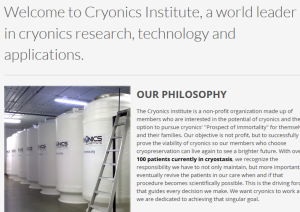
Chances are you’ve seen Encino Man, or you’ve encountered some other work of fiction that revives a person that was frozen, whether accidentally or intentionally. While writing my new book about the frozen tower, one of the elements that I thought would make the book truly exciting is if someone from that culture survived, but how? Placing the tower in the miles of frozen ice of Antarctica would make it a difficult discovery, but could provide a frozen place from which I could revive my character. Of course, I wanted it to be as realistic and believable as possible, so it was time to do some research.
My first stop was Wikipedia, and doing a little research on cryogenics. What I quickly learned was that cryogenics is the study of objects at very low temperatures, but not people. That was actually called cryonics (a common literary misnomer).
So I adjusted my search, and found out some interesting information. First, the big problem with cryonics is the fact that a body has to be frozen nearly instantly in order to prevent the blood and fluids from crystallizing and destroying the cells. While at first this may seem like a daunting task, when you take into account that there were wooly mammoths found having been frozen solid in the middle of eating a nice buttercup dinner, the concept becomes much more plausible.

My next step was to figure out how to revive my character, because it’s just not realistic that he automatically reanimates when he thaws out – that’s pure fiction! *wink*
I decided to check out some cryonics websites to see what they had to offer. The Cryonics Institute’s website really stood out. It was beautifully designed with a very future tech style logo, and it had detailed information on their process.
Interesting factoid: The institute actually flushes out the blood and inserts a vitrification solution to prevent crystallization, rather than simply freezing their clients. 
Once the bodies are fully frozen and ready for storage, they’re placed in these large storage containers – they kind of remind me of giant, futuristic thermoses, though they are equipped with cooling mechanisms to keep the bodies at temperature. Of course, such an environment was a great setting for my book, and I decided that the best place to revive my character was in an environment where they would know the most about frozen people – and CorVita Cryonics was invented.
Interesting factoid: CorVita is Latin for “Heart Life,” because “the life of every creature is its blood” – Leviticus 17:14.
Another interesting feature of the institute was what they call a “thumper.” It’s a device that mimics the pumping action of CPR, but the goal is merely to move the blood around and attempt to prevent the cells from dying while the body is being transported and readied for freezing. I figured if we were reviving someone, we would want to begin moving the blood around as soon as the blood was thawed enough for circulation, and so the thumper added another dramatic element to my scene.
Of course, reviving a person has never been done, so there has to be complications, and even with such an elaborate setup, there is no guarantee that the character will survive, right?
Have you ever thought about cryonics or having your body frozen for future healing? Do you think that reviving frozen people will one day become possible? I would love to hear your thoughts on the subject. Feel free to ask questions, and I’ll see if I can answer them!


